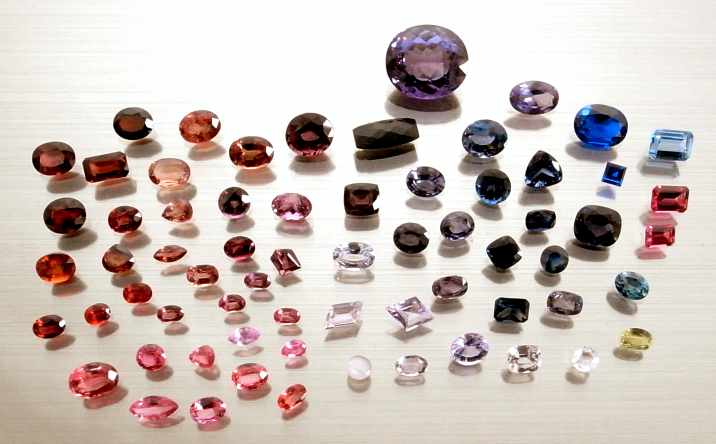 |
| 多彩な色合いを見せるスピネル・ルース Color varieties of faceted spinel |
尖晶石(Spinel)
 |
| 多彩な色合いを見せるスピネル・ルース Color varieties of faceted spinel |
上(top) 27.8ct
下(bottom) 146.43ct
パミール高原(Pamir Mtns.)150ct 32.5x31.5x15.7mm
産地不明( Unknown locality)指輪の石(Ring)9.5ct Mogok, Burma
Others Srilanka 1.89 - 46.68ct
American Museum of Natural History
New York
Spinel is found as a by-product of ruby and sapphire exploitations. Burma and Srilanka always have been the major spinel producers. | ||
ヴェトナムのスピネル(Spinel from Viet Nam)
0.97 - 6.07ct
Con Troi Mine
An Puh1.83 - 7.78ct
Luc Yen area結晶とルース〜2ct
Luc Yen1.71-3.18ct
Lang Chap300gの一つの結晶からカットされたルース
faceted stones from one 300g crystal
Nghe An
石灰岩ー苦灰岩質大理石産
の赤いスピネル 2cm変成大理石上の結晶 4cm ヴェトナム中北部のスピネル産地(Spinel mines of Vietnam) Ruby red spinel from
calcite-dolomite marblePurple spinel derived
from complex marbleYen Bai & Nghe An Lang Chap, Luc Yen Yen The, Luc Yen
1980年代初頭からヴェトナム各地でビルマやスリランカ産に匹敵する高品質のルビーとサファイアの発見が相次ぎ、その採掘に伴い副産物としてスピネルも報告されるようになりました。
2000年以降は北部、中部、南部と全土でルビー、サファイア、トルマリン、アクアマリン、ジルコン、ガーネット等々多彩な宝石が発見され、その後も毎月のように新たな産地が報告されつつあります。
スピネルは主に北部の Yen Bai 地方 Luc Yen周辺とその200km南, 中北部のNghe An 地方の鉱山から産出します。
ルビーのような赤い色のスピネルは石灰岩ー苦灰岩からの結晶大理石脈から、その他の色は複雑な変成作用を受けた大理石に産するとのことです。
Since early 1980's, high quality ruby and sapphires, equivalent to Burmese and Srilankan ones have been discovered in wide areas of Vietnam.
Spinel has been reported as bi-product of ruby and shpphire mining, mainly in the northern Luc Yen, Yen Bai Province and North Central Nghe An Province.
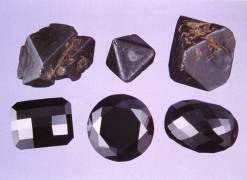 |
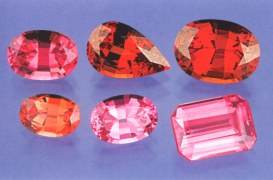 |
| top: 11.43 -
33.88ct bottom : 14.04 - 28.04ct Mesa del Malpais, Nayarit Mexico |
0.68 -
2.28ct Mahenge region, Tanzania |
メキシコのヘルシナイト (Hercynite : black spinel from Mexico)
19世紀末、ヴィクトリア朝時代のイギリスではジェット(褐炭)やメラナイト(鉄やチタンを含むアンドラダイト・ガーネット)と共にスリランカ産のヘルシナイト(鉄分に富むスピネル)などの黒く不透明な宝石がモーニング・ジュエリー(喪装用装飾品)として流行しました。
黒く不透明な宝石は現在では新鮮な感覚で一般的な宝飾品として使われるようになり、ブラック・ダイアモンドと共にヘルシナイトが宝石界に復活しました。
メキシコでは1980年ごろからヘルシナイトの産出が知られていましたが、新たに2000年1月にナヤリト州の粘土化した凝灰岩とアルカリ玄武岩からなる漂砂鉱床にヘルシナイトが発見されましたペリドットと輝石と共に1立米当たり1kgものスピネルが採れます。
In 19th century, at Victorian Era of United Kingdom, opaque gem stones, such as jet, melanite and hercynite were popular as mourning jewellery. Recently, black gemstones like black diamond gain became popular as general purpose jewellery. Mexico was known as hercynite producer since 1920. Recently there was a new find of rich hercynite (black spinel) in Nayarit State. Hercynite is mined in the area of 3.5km2 of terrain, which is underlain by alkali-basalt flows and interlayered mafic tuffs (which are typically altered to clay)
タンザニアのスピネル (Spinels from Tanzania)
タンザニア各地では1960年代から次々に宝石が発見され、現在では数十種類の宝石を産する、世界で有数の宝石産出国となっています。
スピネルはルビー・サファイアと共に発見され、北部のロンギード、ケニア国境のウンバ川流域、中部のモロゴロ周辺、中南部のマヘンゲ、1990年代半ばに発見された最南部のモザンビーク国境に近いトゥンドゥルーの巨大な漂砂鉱床地区が重要な産地です。
紫やピンクのパステルカラーに加えてビルマ、モゴク産の真紅のルビーを髣髴させるものまで、多彩な色のスピネルを産します。
Tanzania emerged in the 1960's as a producer of a great variety of gems such as tanzanite, ruby, sapphire, spinel, garnet, tourmaline : today, more than 50 gem species and varieties are produced.
Spinel is exploited at ruby-sapphire mines ; Longido in north, Umba River Area at Kenyan boarder, Morogoro area in the center, Mahenge at center-south and at huge alluvial deposits along Tunduru area, near Mozambique boarder in the south.
Tanzanian spinel has varieties of shades from pastel color pink and violet to deep red, similar to Mogok ruby.
スピネルという鉱物 (What is spinel ?)
スピネルは酸化アルミニウムと酸化マグネシウムの化合物で等軸晶系の正八面体の美しい結晶形で産出します。
マグネシウムが鉄と置換したヘルシナイト(Hercynite)、亜鉛と置換したガーナイト(Gahnite),鉄と置換したマグネタイト(Magnetite:磁鉄鉱)、或いはクロムと置換してクロマイト(Chromite:クロム鉄鉱)等の類質同像の等軸晶系,正八面体の結晶形を示すスピネル族の鉱物があります。
これらスピネル族の中で宝石質の透明な結晶となるのはマグネシウム・スピネルです。 時に不純物として亜鉛を含み濃紺色を示すスピネルがガーノスピネルと呼ばれますが、ガーナイトではなく、やはりマグネシウム・スピネルです。
スピネルは火成岩や接触変成岩に産しますが、宝石質のものは殆どが結晶石灰岩中にコランダム(ルビー、サファイア)と共に産します。
スピネルとコランダム(ルビーとサファイア)とは下記のように特性が極めて近い上に,色もそっくり、産地によっては結晶形までそっくりです。
Spinel is a compound of magnesia(MgO) and alumina(Al2O3) and is thus a magnesium aluminate(MgAl2O4), found as accessories in igneous rocks, in metamorphosed aluminous schists, in contact metamorphosed limestones and sometimes in high temperature ore veins.
There are common spinel group minerals with chemical substitution between the end members ; MgAl2O4(Spinel), FeAl2O4(Hersinite), ZnAl2O4(Gahnite), MnAl2O4(Galaxite) and FeCr2O4(Chromite).
Among spinel group minerals, only magnesium spinel is found as transparent gem crystals with various colors, mostly in crystalized calcite-marble metamorphosed rocks and its alluvial deposits of Burma, Srilanka, Afghanistan, Vietnam and in Tazania. Spinel and Corundum(Ruby and Sapphire) are very close in chemical compostion and occurence, and often discovered in the same deposits.
化学組成
(Formula)結晶系
(Crystal System)モース硬度
(Hardness)比重
(Density)屈折率
(Refractive Index)スピネル
(Spinel)MgAl2O4 等軸晶系(Cubic) 8 3.58〜3.90 1.712〜762 コランダム
(Corundum)Al2O3 三方晶系(Triclinic) 9 3.97〜4.05 1.759−778
このため、古来から18世紀末に至るまで、この二つの鉱物は同一の鉱物として扱われ、英国王室王冠を飾る"黒太子のルビー”
と呼ばれる巨大なスピネルやチムール ルビーと呼ばれる巨大なスピネルが長い間ルビーとされて来た等、様々な逸話があります。
詳細は"宝石読本 − 嫋やかな野の花たち‐スピネル”を参照ください。
スピネルの成因(Spinel Formation)
Al2O3 + CaMg(CO3)2 → Al2MgO4 + CaCO3 + CO2 コランダム 苦灰岩
( ドロマイト)スピネル 石灰岩
(大理石)二酸化炭素 (Corundum) (Dolomite) (Spinel) Calcite Carbondioxide
スピネルは苦灰岩層に含まれるルビーやサファイアが地殻変動による変成作用を受けて溶融した酸化アルミニウムが周囲の苦灰岩からマグネシウムを取り込んでスピネルに変わったと考えられます。
したがってスピネルはしばしばルビーやサファイアと混在し、色合いや硬度、屈折率等の特性もよく似ています。 そのため長年にわたって、コランダムと混同されていました。
スピネルの産地 (Spinel localities)
スピネルの産地は成因が同じコランダムとほぼ重なりますが、宝石質の結晶の産地はより限られ,産出量は遥かに少なく大変稀少な宝石です。
例えばビルマではコランダムの5分の1、パキスタンのフンザ渓谷では10分の1に過ぎません。
産出量の少なさに加えて、知名度が低い事もあって、一般の宝石店ではスピネルを見かける事は滅多にありません。
Therefore, corundum and spinel have been confused as the same mineral since long time till 18th century. As in case of "Black Prince's Ruby of British Crown and Timur Ruby. Although discovered together with corundum's locality, spinel is a gem far less abundant and rare.
For example, in Burma and Hunza Valley of Pakistan, production ratio of Spinel against corundum is 1/5 and 1/10, each.
Because of the rarity, hence bare public notices, we seldom have an occation to encounter spinel at jewelry shops.
スピネルの発色 (About spinel color)
スピネルの発色は基本的にルビーやサファイアと同じ仕組みで起ります。
化学組成や屈折等の特性も近く,肉眼では識別が困難なため、何世紀もの間、両者が混同されていました。
ただし、サファイアのような金色や黄色はありません。
サファイアで黄色の発色の原因の鉄イオンはスピネルでは青や青緑の発色原因となるからです。
不純物が極めて少なければ両者ともに無色透明ですが,サファイアと比べれば無色のスピネルは大変稀です。
Spinel is colored with similar mechanism as corundum. But yellow spinel does not exist. Iron impurity, which contributes to yellow color in corundum, is a cause of blue and blue-green in spinel.
Since chemical composition and other characteristics are similar, it is quite diffictl to identify spinel from ruby and sapphires with unaided eye, which is the main reason that both gemstones have been confused long time. Both spinel and corundum with pure composition are colorless, while colorless spinel is much rare than corundum.
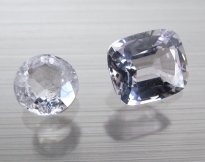 |
||||||
| 0.78ct Ø 6mm |
1.51ct 7.3x6.2mm | |||||
| Mogok,Burma | Pailin, Cambodia | |||||
青いスピネル(Blue spinel)
かつてコバルト着色の青いスピネルは合成のみと言われてきました。が、最近では天然にも発見されるようになりました。
青の発色はニ価のコバルトとニ価の鉄とが構成する配位八面体による光の選択吸収によって起ります。
この場合青から紫を帯びた青になります。
Cobalt colored blue spinel once existed only as synthetic type, but recently natural type is discovered. The blue and purplish blue color derives from octahedral cordination formed with di-valence cobalt and ferric ion.
4.80ct 11x9.2mm
Mogok, Burma3.64ct 9.1x9.1mm
Mogok, Burma2.62ct 8.2ø
Mogok, Burma1.77ct 9.2x7.2mm
Mogok, Burma0.97ct Ø 6.8mm
産地不明 unknown locality
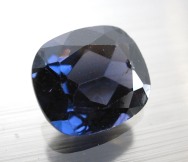 |
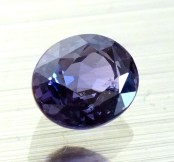 |
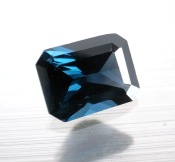 |
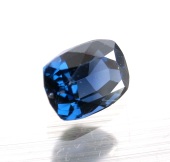 |
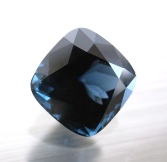 |
| 4.34ct 10.8x9.3mm | 2.23ct 8.0x6.7mm | 1.75ct
7.8x4.8mm Ratnapura |
1.39ct 7.2x5.3mm | 2.21ct 7mm
Kolonne |
| Srilanka | ||||
赤紫 ー 青紫のスピネル(Violet Spinel)
紫のスピネルは鉄イオンの配位八面体による光の選択吸収によります。
鉄の他にクロムやコバルトなどを含むために、赤紫から青紫までの広範な色合いを示します。
Purple and graysh-purple color derived from octahedral cordination of ferric ion.
1.76ct 9.2x7.2mm 1.43ct 8.0x5.4mm 2.12ct 9.6x6.8mmr 1.94ct 8.2x7.2mm 1.09ct 7.0x5.2mm Mogok, Burma Srilanka
1.84ct 8.3x7.5mm 0.90ct 7.3x6.2mm 1.97ct 8.1x7.1mm 1.43ct 11.5x8mm 1.09ct 9x7mm 1.87ct 8.0mmx6.0x4.4mm Srilanka
三価のクロムイオンが加わるとスピネルは赤味を帯びてきます。
Additional tri-valent choromium ion impurity cause reddish shade to spinel.
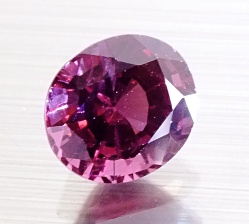 |
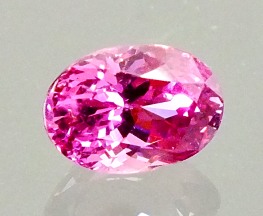 |
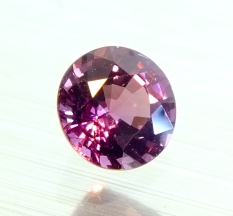 |
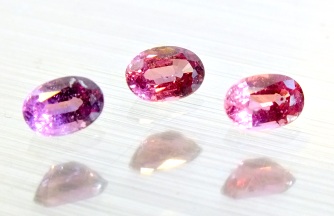 |
| 6.32ct 11.5x10.1mm | 2.82ct 9.5c6.9mm | 1.68ct Ø7.4x5.0mm | 0.59ct(6.1x4.0mm) 0.56ct(6.1x4.0mm) 0.53ct(6x4mm) |
| Mogok, Burma | |||
ラズベリー色のスピネル(Rspbery spinel)
クロムの量が増えるにつれて次第に菫色からオレンジ色のラズベリー色へと変わります。
赤と菫色と橙色とが混じったラズベリー色はスピネルに独特の魅力ある色合いです。
この色のスピネルはスリランカの特産でが、稀にモゴク産にも見られます。
Increasing chromium impurity brings spinel color from purple to raspberry color.
スピネル発色のダイアグラム
( Diagram of Spinel color)
3.12ct 10.5x8.0mm 2.72ct 9.9x7.8mm 2.0ct 7.1x5.1mm
Srilanka0.56ct 7.9x4.1mm 0.99ct 7.5x5.9mm 1.21ct 7.1x5.1mm 0.52ct 6.1x4.1mm 2.82ct 8.5x7.5x6.5mm Srilanka Mogok, Burma
ルビー色のスピネル(Ruby red spinel)
さらにクロム成分比が高くなると濃赤紫から深紅へと連続的に変化します。
スピネルの中では最も高く評価されるのがルビーのような真紅の色です。
肉眼ではルビーとの識別が困難です。
Spinel with higher chromium contents has deep purple to reddish shade, which are highly prized and are
difficult to separate from ruby.
0.35-3.52ct 1.84ct 7.9x6.6mm 0.93ct 7.2x5.2mm 0.73ct 6.8x4.9mm 0.62ct 6x4.9mm Mogok, Burma
暗赤色のスピネル(Dark red spinel)
不純物の鉄成分を多く含むと暗赤色になり、著しく商品価値が下がります。
Higher iron content brings spinel darker red color to lower the market value.
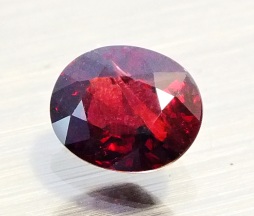
2.43ct 7.8x6.2mm 1.26ct 7.8x6.2mm 2.93ct 10.0x7.9mm 2.69ct 9.6x7.9mm 3.18ct 9.6x8.2mm Mogok, Burma
ピンク・スピネル(Pink spinel)
クロム成分が少なく、かつ不純物の鉄を殆ど含まない場合はピンクになります。
ピンクのスピネルには極めて美しいものがありますが、何故かピンクのサファイアやトパーズと比べて、宝石としての知名度に欠けるためでしょうか、かつては信じられないほど低い評価でした。
事情が変わったのはこの数年です。
タンザニアやビルマから、輝かしい色合いの濃いピンクやルビーとは異なる赤いスピネルが採れるようになり、現在ではカラット当たり10万円〜20万円と、上等なサファイア並みの値段になってきました。
これでも稀少性を勘案すれば、まだ安すぎますから、今後更に高騰することは間違いないでしょう。
Lesser chromium and iron contents brings spinel clean pink color. Some pink spinels are extremely attractive.
However compared with similar colored sapphire and topaz, spinel has been far less prized in the market.
However, new discovery of quite attractive colors, such as bright intense pink and transparent red spinels in Mogok, Burma and Tanzania changed the market evaluation, since past several years.
Today, spinels of those attractive colors fetch US$1,000 to 2,000 and price is being sky-rocketed day-by-day.
0.95ct 7.5x6.0mm 0.89ct 10.5x4.5mm 0.73ct 7.0x4.9mm 1.16ct 8.0x6.0mm 0.39ct 5.1x4.1mm Mogok, Burma
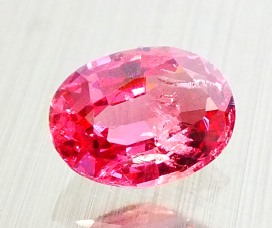 |
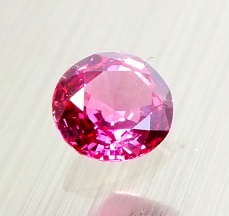 |
 |
 |
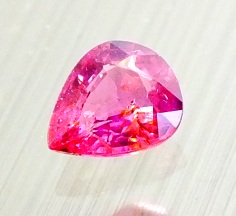 |
| 2.94ct 9.6x6.8mm | 0.93ct Ø6.1mm | 0.43ct 7x4mm | 0.41ct | 0.62ct |
| Srilanka | ||||
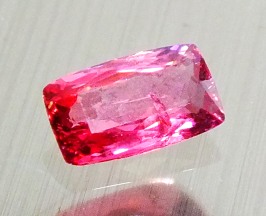 |
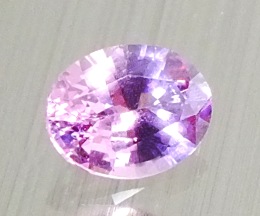 |
 |
| 1.26ct 8.48x5.12mm | 1.00ct 7.15x5.65mm | 0.64ct 5.8x4.3mm |
| Pamir Mtn. Tajikistan | ||
緑色のスピネル(Green spinel)
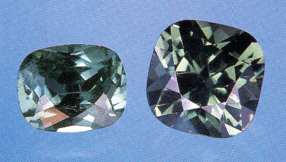 |
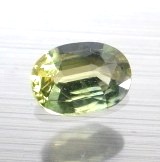 |
| 0.78ct
1.21ct Ilakaka, Madagascar |
0.80ct
7.1x5.1mm Umba Valley, Tanzania |
緑色はスピネルとしては珍しい色です。左の写真のやや灰色を帯びた青緑色は二価と三価の鉄イオンによる格子間電荷移動による着色です。
右の写真の若草色はこれまで報告されたことのない緑です。緑のサファイアと同じ、三価の鉄イオンによる八面体配位と他のイオンの電荷移動との組み合わせによる稀な発色例ではないかと考えられます。
Green is quite rare color for spinel. Grayish blue-green spinel on the left photo is colored by inter-valence charge transfer with di-valent and tri-valent ferric ion. Pale yellowish green spinel from Umba Valley, Tanzania on the right photo is unique and was never reported before. The mechanism seemsto be similar to green saphire ; combination of octahedral cordination of tri-valent ferric ion and charge transfer of some other ion.
キャッツ・アイとスター・スピネル(Cat's eye and star spinel)
キャッツ・アイやスター等の効果を見せる宝石があります。これは鉱物の内部に含まれた他の鉱物の微細な結晶が結晶軸に沿って並んでいる場合に結晶軸を中心にカボション・カットされた時に、内包される不純物の結晶が表面に浮かび上がって見える現象です。
1.83ct spinel, shows 6 ray and cross star Twin Star 2.12ct 3.41ct 1.12ct 0.88ct Ø5.5mm 産地不明(Locality unknown) Srilanka Srilanka Mogok, Burma
不純物を含んで透明度が失われるため、大半は美しくありませんが、稀に透明度が高く美しい色合いを持つ宝石は極めて高価で取引されます。
スピネルの場合、こうした効果を示す例はごく稀にしかありません。写真の最後を除く4例は、Gems & Gemology 誌 に過去30年間に報告された例です。
従って市場で見かける機会は殆どありません。
ぼんやりとキャッツ・アイらしい変彩が浮かぶ0.88ctのルースに一度出会ったのみです。
Inclusions in minerals sometimes reveals cat's-eye and star effects when cut in cabochon form.
Although, most of these stones are opaque or translucent with dull color, due to inclusions, rare transparent stones with beautiful colors are highly prized.
Cat's-eye and star spinels are so rare that only four cases are presented on Gems & Gemology since past 30 years.
スピネル結晶について (Spinel crystal)
スピネルの名はラテン語の ”スピナ=棘”が語源です。
母岩に埋もれた八面体の結晶の尖った先端が薔薇の棘のように見える産状に因む命名でしょう。
モース硬度が8と高く強靭なため、母岩が風化して結晶のみが漂砂鉱床に流されても水磨礫にはならず、美しい結晶形が保たれます。
とりわけビルマのモゴクとスリランカの漂砂鉱床からはほぼ完璧な八面体結晶が発見されます。 美しい結晶は表面のみを研磨してエンジェルカットと呼ばれて宝飾品に使われることがあります。
The name ”spinel” derives from Latin "spina = thorn", refering to the triangular shape of the crystal faces. Thanks to high
Mohs hardness of 8, and toughness, beautiful octahedral crystal shapes are often kept in alluvial deposits. Mogok, Burma and Srilankan alluvial deposits are renowned for the production of perfect octahedron crystals, which crystal shapes are simply cleaned to be called " Angel cut" and are used for jewelry as it is.
石灰岩中のスピネル結晶(Spinel crystals in calcite)
9mm/22mm パミール高原(Pamir Mtns.)大理石上のスピネル結晶 Spinel crystals on marble 1cm
フンザ渓谷 パキスタン Hunza Valley, Pakistan
スピネル結晶
Spinel crystal
on calcite 11mm
Mogok, Burma稀な12面体のスピネル結晶 6mm
Rare dodecahedral crystal
Tunduru, Tanzania石灰岩上の青いスピネル結晶
7 - 9mm 12mm
Blue Spinel crystals on Calcite
Pakistanスピネル結晶マトリクス
Spinel crystal matrix
31x28x25mm
Embilipitiya, Srilanka
天然の結晶 (Natural crystal)
0.46ct(5mm) - 6.13ct(11mm) Mogok, Burmaエンジェルカット結晶 (Angel cut crystal)
0.52ct(4.7mm) -3.55ct(11mm) Mogok, Burma
合成スピネル (Synthetic Spinel)
フラックス法合成スピネル結晶(Flux type synthetic spinel crystals) 火炎溶融法合成スピネル
(Flame fusion
synthetic spinel )ロシア科学アカデミー
Science Academy, Novosibirsk, Russiaガーナイト(Gahnite)
0.47〜23.25ct13.81ct 18.5x13.6x10.5mm ベル研究所(Bell Laboratory)1970's
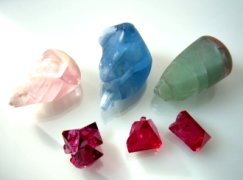 |
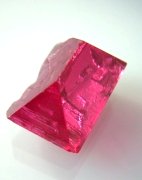 |
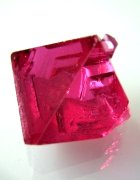 |
| 上 失敗した火炎溶融法スピネル結晶 top : failed flame fusion crystal 下 フラックス法合成スピネル結晶 bottom : Flux synthetiv crystal |
フラックス法合成スピネル結晶 Flux type synthetic crystal 9.63ct 14x10x9mm 10.05ct 115x13x11mm Science Academy, Novosibirsk, Russia | |
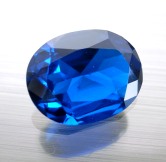 |
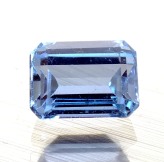 |
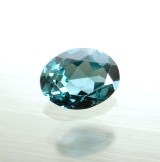 |
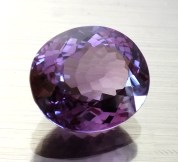 |
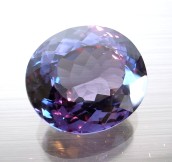 |
| 5.37ct 13x10mm | 4.24ct 10x7.5mm | アレクサンドライト模造色 32.16ct 19.8x17.4mm | ||
| 1.34ct 8.0x5.1mm | 自然光(Daylight) | 白熱光(Incandescent light) | ||
green for emerald, purple for alexandrite, etc. etc., resulting in cheating consumers.
合成スピネルは1880年代半ばにフラックス法でコランダム合成の実験の過程で作られたと言う記録があります。
しかし量産技術は、同じくフランスのヴェルヌイユが青いサファイアを合成する為に5年間余りの試行錯誤を繰り返す過程で、1910年頃、偶々酸化アルミニウムにマグネシウムと着色剤のコバルトとを混ぜたために青い色のスピネルが出来てしまったのが発端です。
と言うと如何にも簡単に合成されてしまったとの印象を受けます。
しかし実際には火炎溶融法のスピネル合成は酸化アルミニウムと酸化マグネシウムとの比率を天然と同じくすると結晶に罅が入りやすく、焼き鈍しの際に酸化アルミニウムが分離して結晶が濁ってしまったりと、困難を伴います。
上の写真は失敗した火炎溶融法による結晶の例です。
ヴェルヌイユ法による合成は,後に材料の比率や精製法、温度調整法等の改善によるファルケン・バーガー法が導入されて,ようやく直径55mmの結晶が得られるようになりました。
第二次世界大戦後、1950年半ば以降、日本人の生活がどうにか貧困を脱しはじめた頃、当時の宝石店や時計店に並び始めたのが火炎溶融法の合成ルビーやサファイアと共に合成スピネルでした。
しかしスピネルは昔から宝石としては全く知名度が低く、無色のスピネルはジルコン,空色はアクアマリン、淡緑色はエメラダと称してエメラルドの、さらに酸化クロムと酸化ヴァナジウムを添加した紫色はアレクサンドライトと、いずれも当時はまず見ることも出来なかった天然の宝石の代用品として売られていたのでした。
現在市場に登場する合成スピネルの大半はアレクサンドライトを模した色合いのスピネルです。ネット市場などでは堂々と天然、或いは本物の合成アレクサンドライトと称して、天然の最上級品の写真を引き合いに売られている場合があり、要注意ですが、数千円〜1万円程度の値段ですから、深刻な被害にはなりません。
サファイアやスピネルに酸化ヴァナジウムを添加したものは確かに天然の最上級品の白熱光下での濃い赤紫色にそっくりですが、自然光でも天然のような濃い緑色ではなく、色変わりはしませんから、識別は容易です。
写真のその他の色合いは、素晴らしくきれいなサファイアやアクアマリンを偲ばせるもので、全て中国で大量に生産され、中国市場向けの宝飾品として販売されています。
タイ、香港、シンガポール等で無知な外国人観光客に高値で売られていることもあります。
くれぐれも怪しげな屋台の店で宝飾品などには手を出さないことです。
天然のスピネルでさえも知名度が低いのですから、まして合成スピネルが売れる筈もありません。
今日、合成スピネルは主に光学材料、誘電体、IC基盤用等の工業用が主な目的で利用されています。
フラックス法による実験的なスピネル合成が1970年代にアメリカのベル研究所で行われました。
マグネシウムではなく亜鉛スピネルです。
亜鉛スピネルの合成は高温の火炎溶融法では不可能なので、フラックス法にての試験的な合成が試みられた様です。
1980年代央頃にはロシアの科学アカデミーでもフラックス法で赤と青のスピネルが合成され、1990年代初頭からタイとの合弁会社Thairus社から年間5000カラット程度の結晶と0.5〜5カラット程度の大きさのファセットされたルースが市場に出るようになりました。
There is a report that spinel was synthesized in the middle of 1880s. The mass production technology was established around 1910 through the experimentaions of French chemist Verneuil trying to synthesise blue sapphire, using flame fusion method for five years of try and erros.
He happened to mix alumina with magnesia and cobalt, as coloring agent, to succeed in synthetic blue spinel, instead of blue sapphire.
As shown in the photo of failed crystal, spinel synthesis by flame fusion method requires careful attentions on the refinement of materials and their ratio and temperature control etc. etc., which was finally realized by sophisticated Falken-Berguer method.
After 2nd world war, synthetic spinel appeared in the jewelery market, with varieties of colors, in the manner to substitute natural gemstones ; colorsless for zircon, pale blue for aquamarine, pale
Today spinel is synthesized for industrial purpose, in electronics and optical field.
In 1970s, experimental flux syntheis was tried by Bell Laboratory of U.S.A. It was not magnesia spinel but zinc spinel, which synthesis at high temperature flame fusion was impossible. In 1980s, Science Academy of Russia have succeeded in establishing mass production of red and blue spinel by flux method. And Thairuss (Joint Venture between Thailand and Russia) started to commercialize faceted stone from 0.5 to 5 carat loose and 5000 carats of crystals per year.
ロシア製フラックス法合成スピネル
(Russian Flux type synthetic spinel)
 |
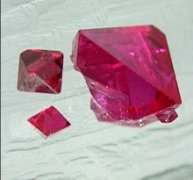 |
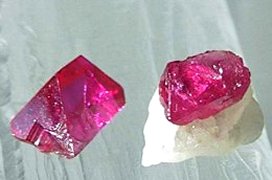 | |||||
| 1.08ct 7x5mm |
2.13ct 9x7mm |
0.5ct 5x5mm |
天然の結晶 (Natural) Burma |
合成結晶 15mm (flux synthetic) |
合成結晶 15mm (Flux synthetic) |
天然の結晶 (Natural) Burma | |
ロシアのフラックス法合成スピネルは結晶形が天然のそれとほぼ同一です。
また化学組成、比重,屈折率等も天然のそれと重なリます。
しかし,フラックス法の合成宝石に特有の気泡や指紋状の包有物、フラックス(溶剤)
として使われるモリブデン、鉛等の破片,また坩堝の材質のプラチナやイリジウム片等の
混入物が見られるために、鉱物用の実体双眼顕微鏡での識別が可能です。
Russian flux method synthetic spinel has similar crystal form as natural one. And chemical composition, specific gravity and refractive index are eqaual to natural spinels. However, common characteristics in flux method synthesized crystals, such as ; veil and finger print like inclusions, inclusions of flux materials ; molibden and zinc fractures together with inclusions of crucibles ; platinum and iridium are seen in crystals, which enables to identify synthesis from natural.